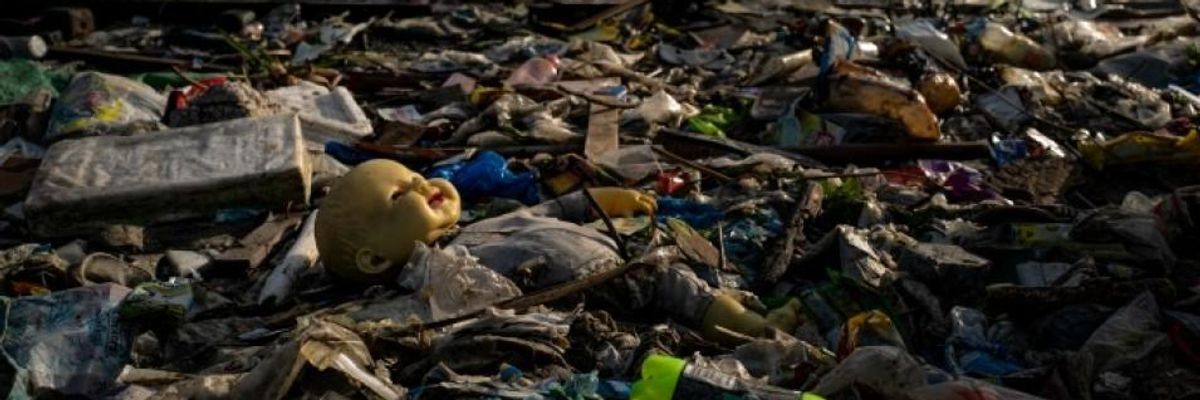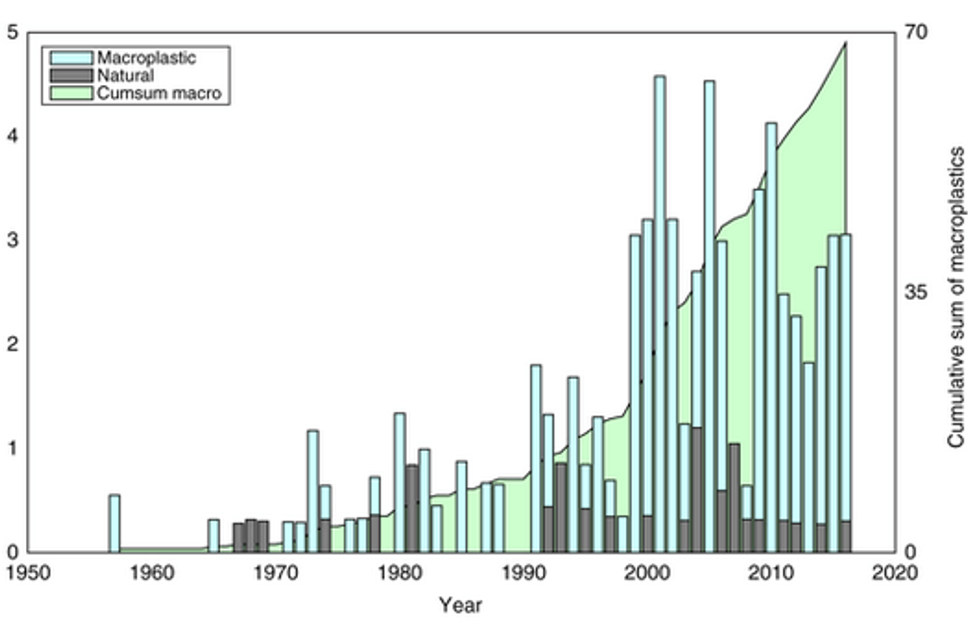

SUBSCRIBE TO OUR FREE NEWSLETTER
Daily news & progressive opinion—funded by the people, not the corporations—delivered straight to your inbox.
5
#000000
#FFFFFF
To donate by check, phone, or other method, see our More Ways to Give page.


Daily news & progressive opinion—funded by the people, not the corporations—delivered straight to your inbox.

Plastic waste fills a beach on April 18, 2018 in Manila, Philippines. (Photo: Jes Aznar/Getty Images)
The equipment was towed across millions of miles of ocean for six decades by marine scientists, meant to collect plankton--but its journeys have also given researchers a treasure trove of data on plastic pollution.
The continuous plankton reporter (CPR) was first deployed in 1931 to analyze the presence of plankton near the surface of the world's oceans. In recent decades, however, its travels have increasingly been disrupted by entanglements with plastic, according to a study published in Nature Communications on Tuesday.
"The message is that marine plastic has increased significantly and we are seeing it all over the world, even in places where you would not want to, like the Northwest Passage and other parts of the Arctic," Clare Ostle, a researcher at the Marine Biological Association in Plymouth, England, told the Guardian.
\u201cOur latest paper using the Continuous Plankton Recorder (CPR), 60 years of data, over 6 million nautical miles reveals significant increase in plastic pollution in Atlantic. Just published in Nature Communications in collaboration with @ClareOstle @thembauk, #macroplastics\u201d— Prof. Richard C Thompson OBE FRS (@Prof. Richard C Thompson OBE FRS) 1555440642
\u201cIt\u2019s called the continuous plankton recorder and it comes from Plymouth but what\u2019s inside it has inadvertently gathered important data about plastic from around the globe since the 1930\u2019s. Can it help fix our plastic pollution problems? \u2066@BBCSpotlight\u2069 \u2066@BBCDevon\u2069\u201d— Airdrop_Bot (@Airdrop_Bot) 1555431160
The CPR originated in northern England and has been continuously towed by boats across more than 6.5 million miles of ocean for more than 60 years.
It was first disrupted by plastic entanglement in 1957, when a fishing line got in its way. Eight years later the CPR ran into a plastic bag. The disruptions became increasingly common in the following years.

By the 1990s, two percent of the CPR's missions were disrupted by plastic pollution--mainly discarded nets and other fishing equipment, as well as other plastic products.
The rate of disruption is now between three and four percent, according to scientists at the Marine Biological Association and the University of Plymouth, who compiled the research.
The CPR is pulled by boats at a depth of about 22 feet (7 meters) below the ocean surface, where many marine creatures live--confirming earlier studies which have found that marine life has been increasingly threatened by plastic pollution.
"The realization that plastics are ubiquitous, and that the consequent health impacts are yet to be fully understood, has increased the awareness surrounding plastics," the report reads. "There is a need for re-education, continued research, and awareness campaigns, in order to drive action from the individual as well as large-scale decisions on waste-management and product design."
"The dataset presented here," the authors said, "is an important historical record for the continued monitoring of plastics in the ocean, and confirms the importance of actions to reduce and improve plastic waste."
Dear Common Dreams reader, The U.S. is on a fast track to authoritarianism like nothing I've ever seen. Meanwhile, corporate news outlets are utterly capitulating to Trump, twisting their coverage to avoid drawing his ire while lining up to stuff cash in his pockets. That's why I believe that Common Dreams is doing the best and most consequential reporting that we've ever done. Our small but mighty team is a progressive reporting powerhouse, covering the news every day that the corporate media never will. Our mission has always been simple: To inform. To inspire. And to ignite change for the common good. Now here's the key piece that I want all our readers to understand: None of this would be possible without your financial support. That's not just some fundraising cliche. It's the absolute and literal truth. We don't accept corporate advertising and never will. We don't have a paywall because we don't think people should be blocked from critical news based on their ability to pay. Everything we do is funded by the donations of readers like you. Will you donate now to help power the nonprofit, independent reporting of Common Dreams? Thank you for being a vital member of our community. Together, we can keep independent journalism alive when it’s needed most. - Craig Brown, Co-founder |
The equipment was towed across millions of miles of ocean for six decades by marine scientists, meant to collect plankton--but its journeys have also given researchers a treasure trove of data on plastic pollution.
The continuous plankton reporter (CPR) was first deployed in 1931 to analyze the presence of plankton near the surface of the world's oceans. In recent decades, however, its travels have increasingly been disrupted by entanglements with plastic, according to a study published in Nature Communications on Tuesday.
"The message is that marine plastic has increased significantly and we are seeing it all over the world, even in places where you would not want to, like the Northwest Passage and other parts of the Arctic," Clare Ostle, a researcher at the Marine Biological Association in Plymouth, England, told the Guardian.
\u201cOur latest paper using the Continuous Plankton Recorder (CPR), 60 years of data, over 6 million nautical miles reveals significant increase in plastic pollution in Atlantic. Just published in Nature Communications in collaboration with @ClareOstle @thembauk, #macroplastics\u201d— Prof. Richard C Thompson OBE FRS (@Prof. Richard C Thompson OBE FRS) 1555440642
\u201cIt\u2019s called the continuous plankton recorder and it comes from Plymouth but what\u2019s inside it has inadvertently gathered important data about plastic from around the globe since the 1930\u2019s. Can it help fix our plastic pollution problems? \u2066@BBCSpotlight\u2069 \u2066@BBCDevon\u2069\u201d— Airdrop_Bot (@Airdrop_Bot) 1555431160
The CPR originated in northern England and has been continuously towed by boats across more than 6.5 million miles of ocean for more than 60 years.
It was first disrupted by plastic entanglement in 1957, when a fishing line got in its way. Eight years later the CPR ran into a plastic bag. The disruptions became increasingly common in the following years.

By the 1990s, two percent of the CPR's missions were disrupted by plastic pollution--mainly discarded nets and other fishing equipment, as well as other plastic products.
The rate of disruption is now between three and four percent, according to scientists at the Marine Biological Association and the University of Plymouth, who compiled the research.
The CPR is pulled by boats at a depth of about 22 feet (7 meters) below the ocean surface, where many marine creatures live--confirming earlier studies which have found that marine life has been increasingly threatened by plastic pollution.
"The realization that plastics are ubiquitous, and that the consequent health impacts are yet to be fully understood, has increased the awareness surrounding plastics," the report reads. "There is a need for re-education, continued research, and awareness campaigns, in order to drive action from the individual as well as large-scale decisions on waste-management and product design."
"The dataset presented here," the authors said, "is an important historical record for the continued monitoring of plastics in the ocean, and confirms the importance of actions to reduce and improve plastic waste."
The equipment was towed across millions of miles of ocean for six decades by marine scientists, meant to collect plankton--but its journeys have also given researchers a treasure trove of data on plastic pollution.
The continuous plankton reporter (CPR) was first deployed in 1931 to analyze the presence of plankton near the surface of the world's oceans. In recent decades, however, its travels have increasingly been disrupted by entanglements with plastic, according to a study published in Nature Communications on Tuesday.
"The message is that marine plastic has increased significantly and we are seeing it all over the world, even in places where you would not want to, like the Northwest Passage and other parts of the Arctic," Clare Ostle, a researcher at the Marine Biological Association in Plymouth, England, told the Guardian.
\u201cOur latest paper using the Continuous Plankton Recorder (CPR), 60 years of data, over 6 million nautical miles reveals significant increase in plastic pollution in Atlantic. Just published in Nature Communications in collaboration with @ClareOstle @thembauk, #macroplastics\u201d— Prof. Richard C Thompson OBE FRS (@Prof. Richard C Thompson OBE FRS) 1555440642
\u201cIt\u2019s called the continuous plankton recorder and it comes from Plymouth but what\u2019s inside it has inadvertently gathered important data about plastic from around the globe since the 1930\u2019s. Can it help fix our plastic pollution problems? \u2066@BBCSpotlight\u2069 \u2066@BBCDevon\u2069\u201d— Airdrop_Bot (@Airdrop_Bot) 1555431160
The CPR originated in northern England and has been continuously towed by boats across more than 6.5 million miles of ocean for more than 60 years.
It was first disrupted by plastic entanglement in 1957, when a fishing line got in its way. Eight years later the CPR ran into a plastic bag. The disruptions became increasingly common in the following years.

By the 1990s, two percent of the CPR's missions were disrupted by plastic pollution--mainly discarded nets and other fishing equipment, as well as other plastic products.
The rate of disruption is now between three and four percent, according to scientists at the Marine Biological Association and the University of Plymouth, who compiled the research.
The CPR is pulled by boats at a depth of about 22 feet (7 meters) below the ocean surface, where many marine creatures live--confirming earlier studies which have found that marine life has been increasingly threatened by plastic pollution.
"The realization that plastics are ubiquitous, and that the consequent health impacts are yet to be fully understood, has increased the awareness surrounding plastics," the report reads. "There is a need for re-education, continued research, and awareness campaigns, in order to drive action from the individual as well as large-scale decisions on waste-management and product design."
"The dataset presented here," the authors said, "is an important historical record for the continued monitoring of plastics in the ocean, and confirms the importance of actions to reduce and improve plastic waste."